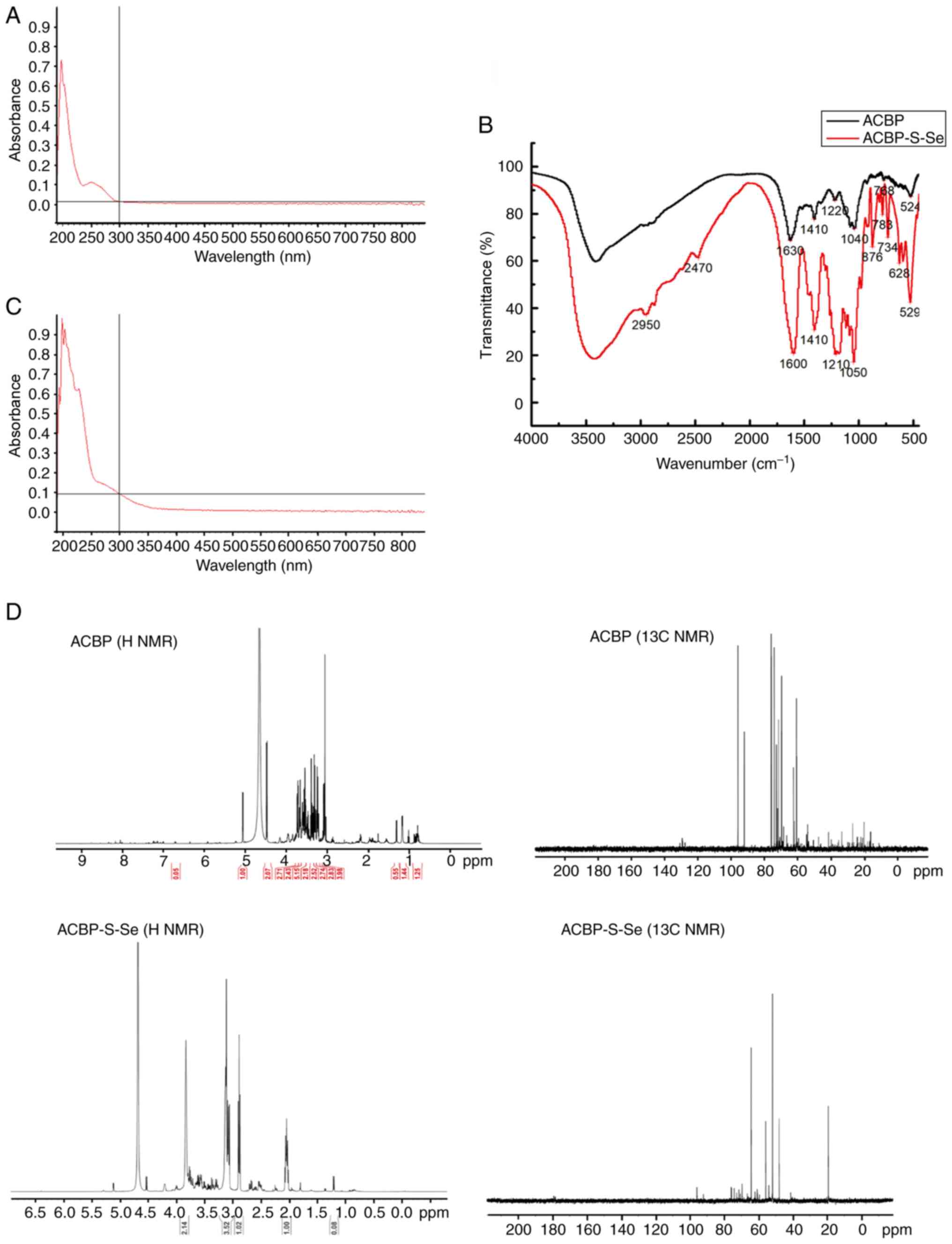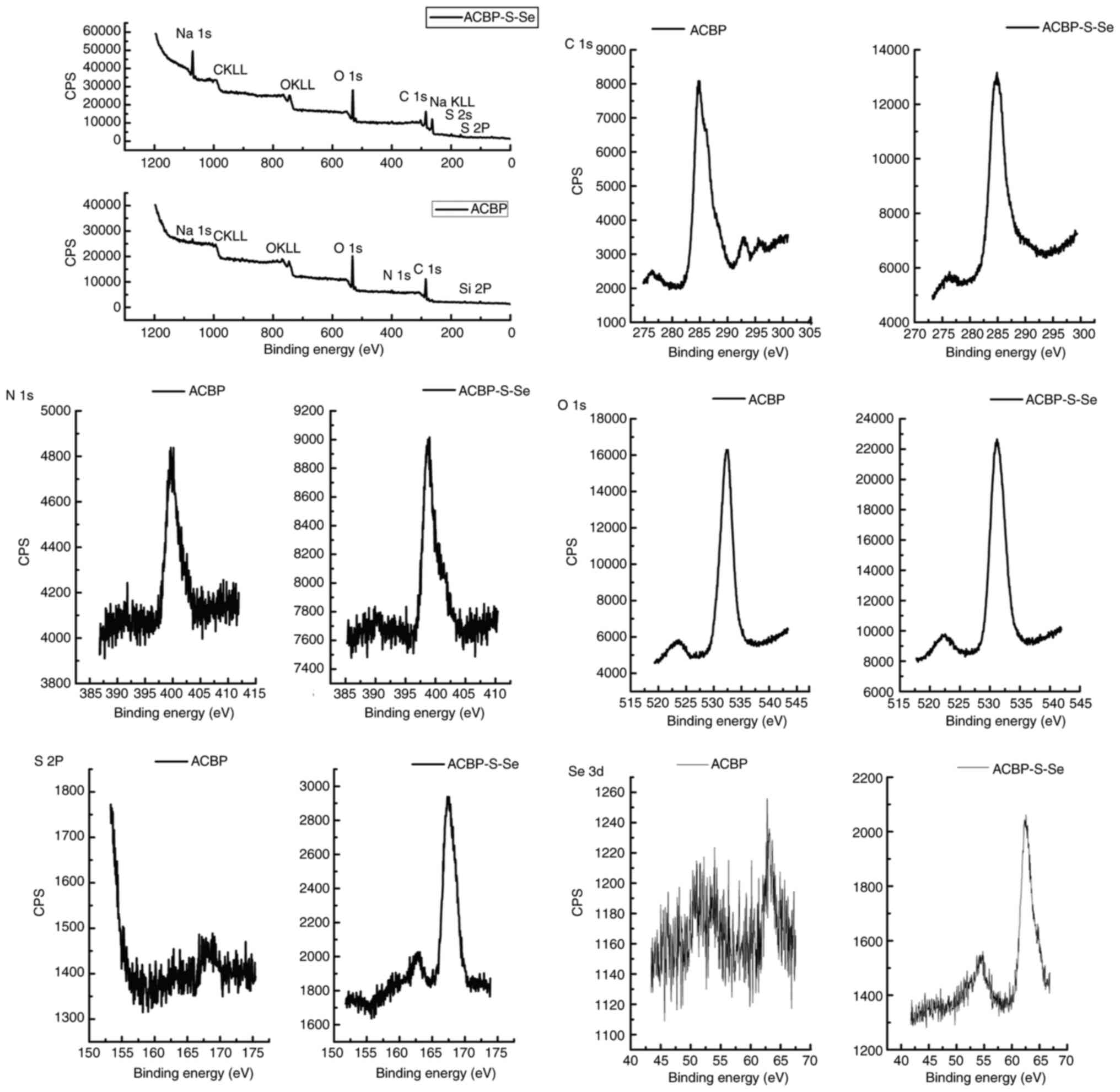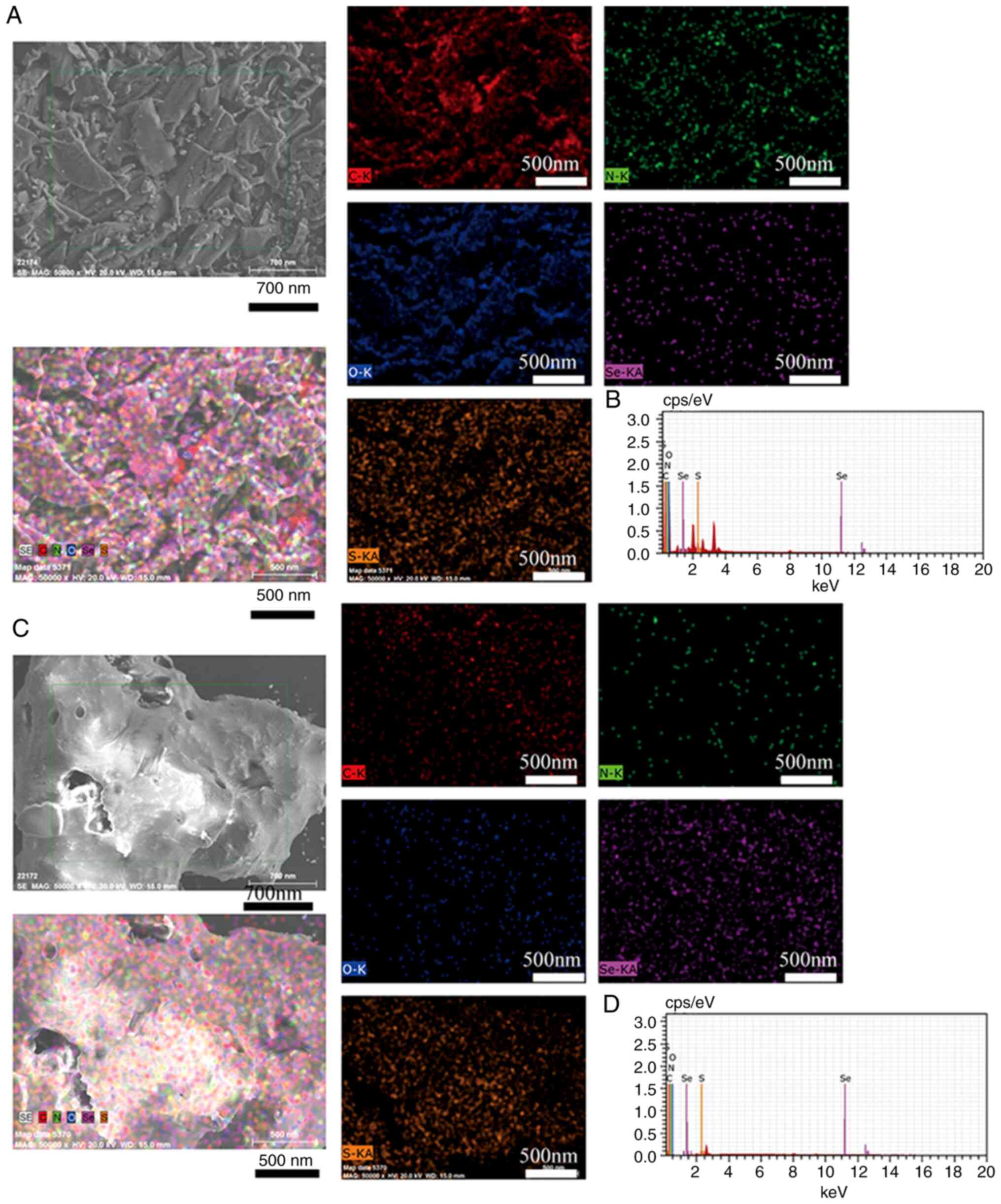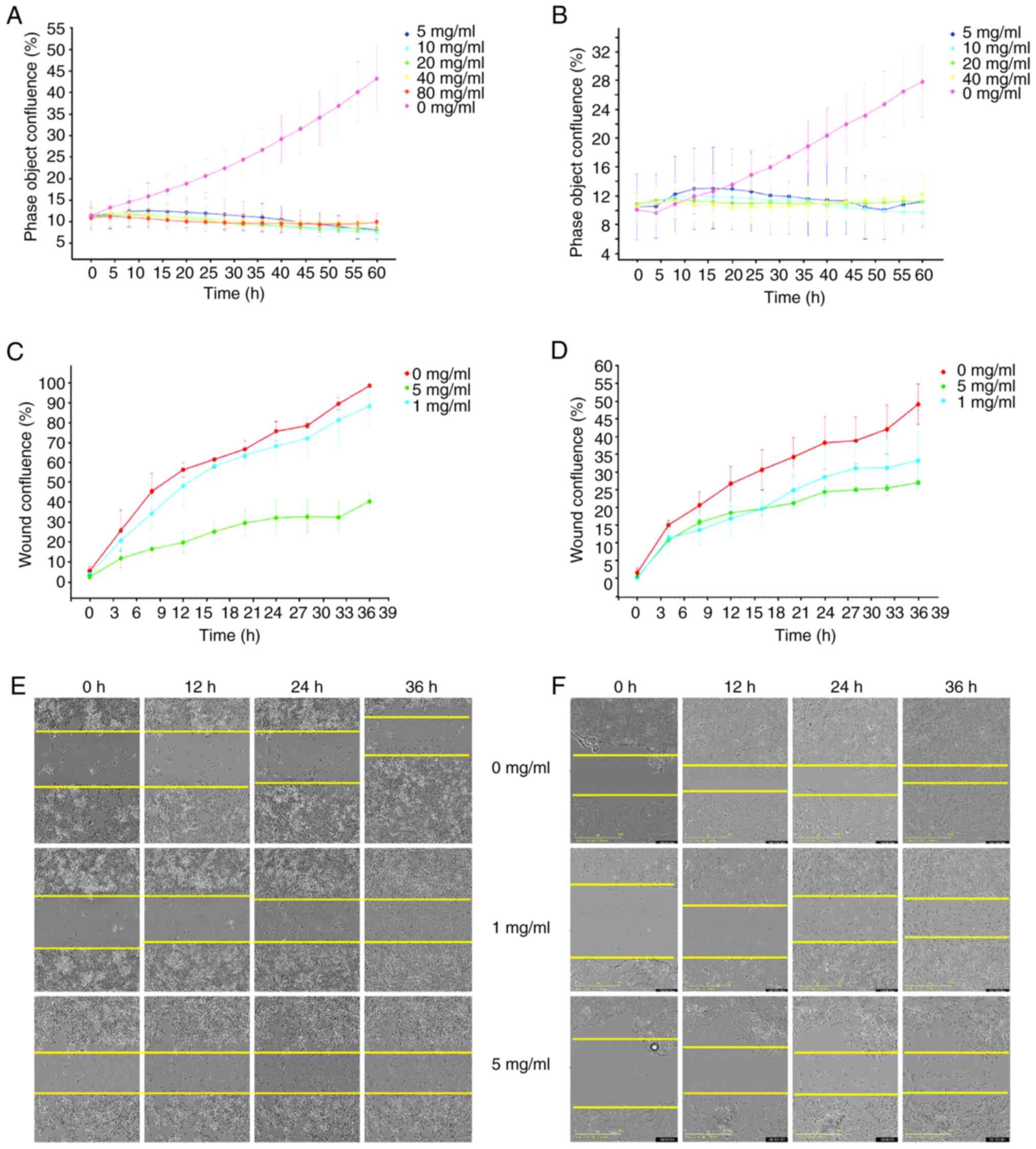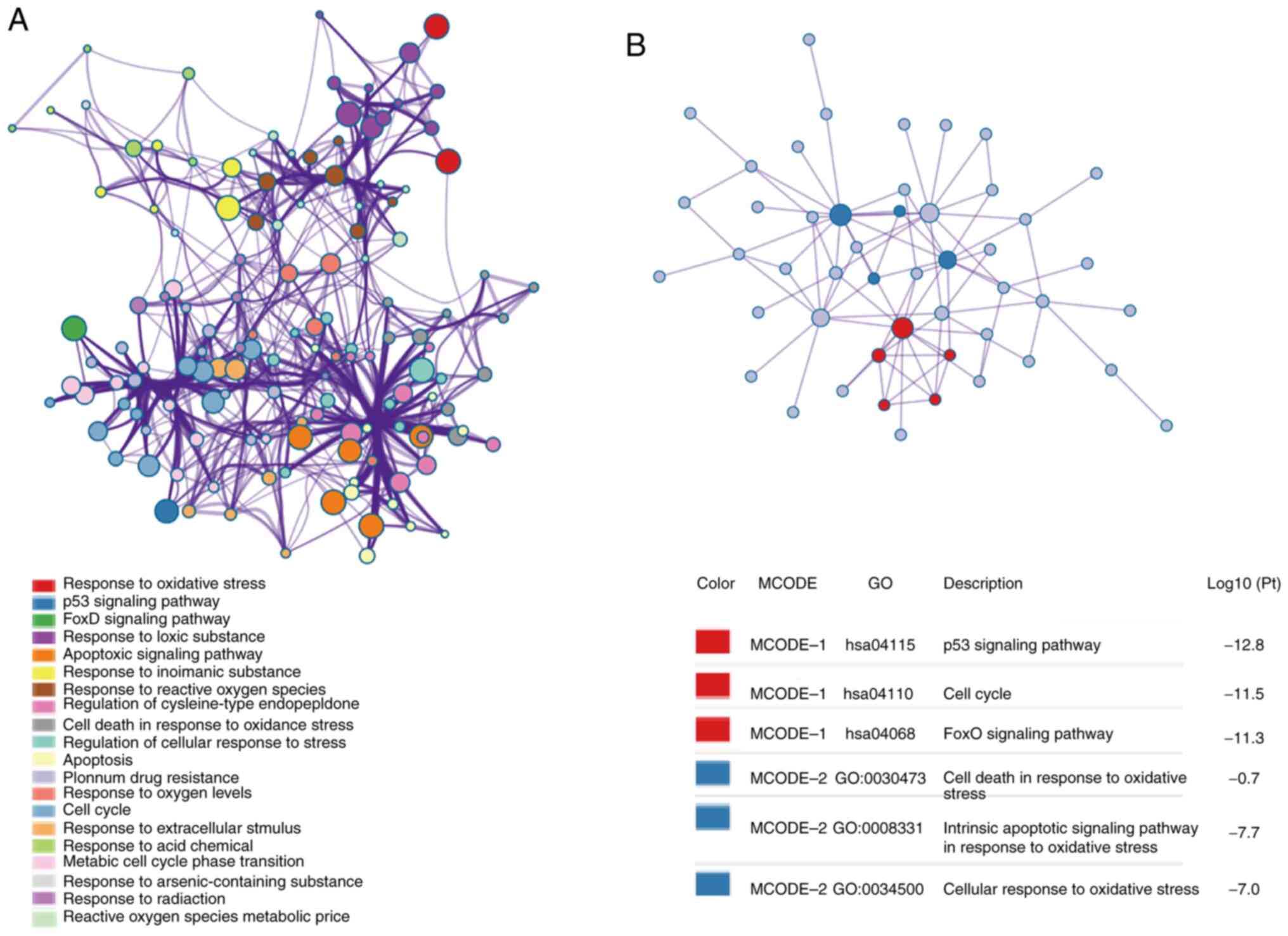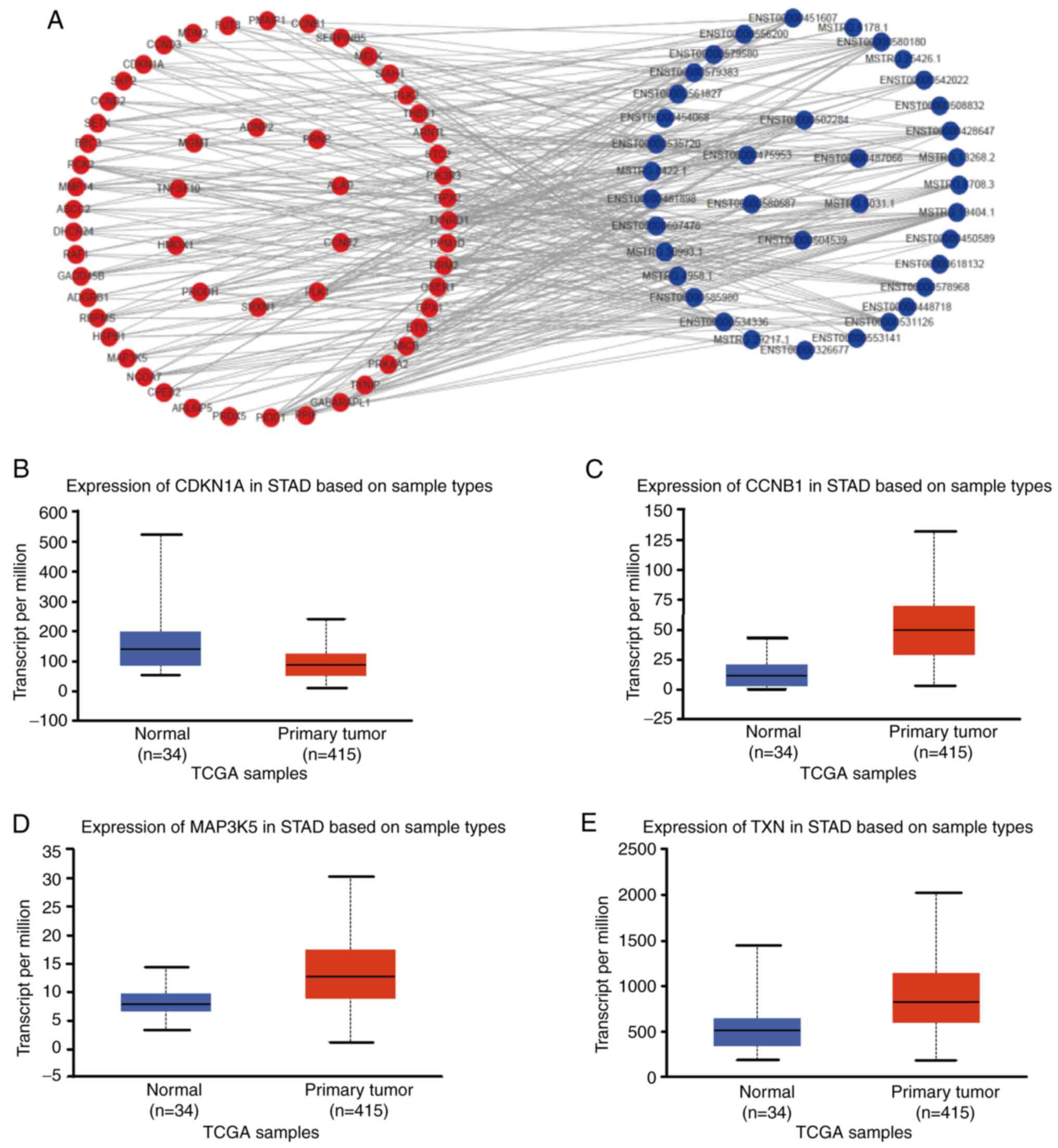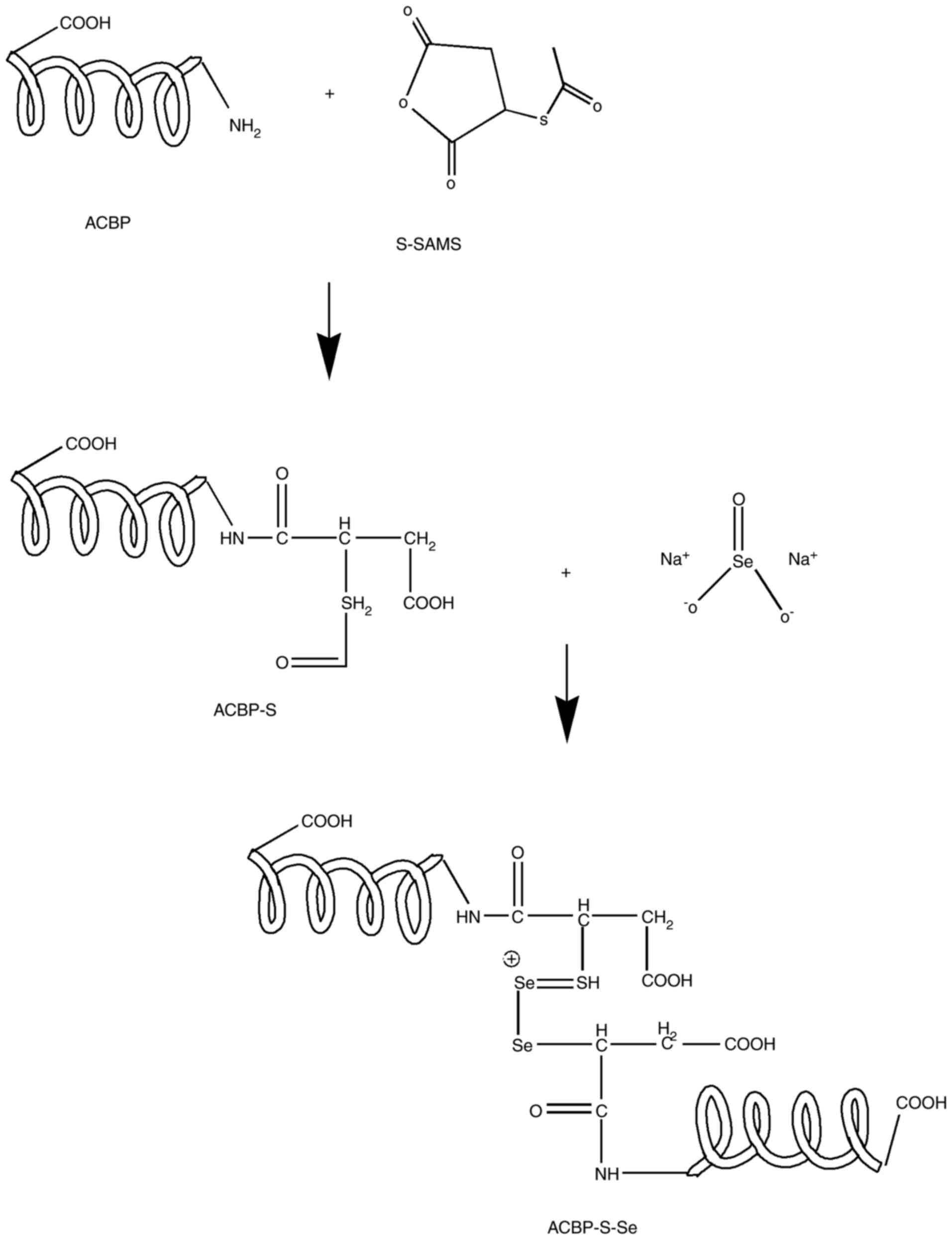|
1
|
Moloney JN and Cotter TG: ROS signalling
in the biology of cancer. Semin Cell Dev Biol. 80:50–64. 2018.
View Article : Google Scholar
|
|
2
|
Huang T, Wang-Johanning F, Zhou F, Kallon
H and Wei Y: MicroRNAs serve as a bridge between oxidative stress
and gastric cancer (Review). Int J Oncol. 49:1791–1800. 2016.
View Article : Google Scholar : PubMed/NCBI
|
|
3
|
Ismail T, Kim Y, Lee H, Lee DS and Lee HS:
Interplay between mitochondrial peroxiredoxins and ROS in cancer
development and progression. Int J Mol Sci. 20:44072019. View Article : Google Scholar :
|
|
4
|
Zhang P, Shi L, Zhang T, Hong L, He W, Cao
P, Shen X, Zheng P, Xia Y and Zou P: Piperlongumine potentiates the
antitumor efficacy of oxaliplatin through ROS induction in gastric
cancer cells. Cell Oncol (Dordr). 42:847–860. 2019. View Article : Google Scholar
|
|
5
|
Gu H, Huang T, Shen Y, Liu Y, Zhou F, Jin
Y, Sattar H and Wei Y: Reactive oxygen species-mediated tumor
microenvironment transformation: The mechanism of radioresistant
gastric cancer. Oxid Med Cell Longev. 2018:58012092018. View Article : Google Scholar : PubMed/NCBI
|
|
6
|
Yu Y, Cui Y, Niedernhofer LJ and Wang Y:
Occurrence, biological consequences, and human health relevance of
oxidative stress-induced DNA damage. Chem Res Toxicol.
29:2008–2039. 2016. View Article : Google Scholar : PubMed/NCBI
|
|
7
|
Bao B, Azmi AS, Li Y, Ahmad A, Ali S,
Banerjee S, Kong D and Sarkar FH: Targeting CSCs in tumor
microenvironment: The potential role of ROS-associated miRNAs in
tumor aggressiveness. Curr Stem Cell Res Ther. 9:22–35. 2014.
View Article : Google Scholar
|
|
8
|
Fuloria S, Subramaniyan V, Karupiah S,
Kumari U, Sathasivam K, Meenakshi DU, Wu YS, Sekar M, Chitranshi N
and Malviya R: Comprehensive review of methodology to detect
reactive oxygen species (ROS) in mammalian species and establish
its relationship with antioxidants and cancer. Antioxidants
(Basel). 10. pp. 1282021, View Article : Google Scholar
|
|
9
|
Choudhari SK, Chaudhary M, Gadbail AR,
Sharma A and Tekade S: Oxidative and antioxidative mechanisms in
oral cancer and precancer: A review. Oral Oncol. 50:10–18. 2014.
View Article : Google Scholar
|
|
10
|
Kruk J and Aboul-Enein HY: Reactive oxygen
and nitrogen species in carcinogenesis: Implications of oxidative
stress on the progression and development of several cancer types.
Mini. Rev Med Chem. 17:904–919. 2017.
|
|
11
|
Panhwar A, Tuzen M and Kazi T: Ultrasonic
assisted dispersive liquid-liquid microextraction method based on
deep eutectic solvent for speciation, preconcentration and
determination of selenium species (IV) and (VI) in water and food
samples. Talanta. 175:352–358. 2017. View Article : Google Scholar : PubMed/NCBI
|
|
12
|
Zachariah M, Maamoun H, Milano L, Rayman
MP, Meira LB and Agouni A: Endoplasmic reticulum stress and
oxidative stress drive endothelial dysfunction induced by high
selenium. J Cell Physiol. 236:4348–4359. 2021. View Article : Google Scholar
|
|
13
|
Cai X, Wang C, Yu W, Fan W, Wang S, Shen
N, Wu P, Li X and Wang F: Selenium exposure and cancer risk: An
updated meta-analysis and meta-regression. Sci Rep. 6:192132016.
View Article : Google Scholar : PubMed/NCBI
|
|
14
|
Gheorghiu ML and Badiu C: Selenium
involvement in mitochondrial function in thyroid disorders.
Hormones (Athens). 19:25–30. 2020. View Article : Google Scholar
|
|
15
|
Liu Q, Zhao X, Ma J, Mu Y, Wang Y, Yang S,
Wu Y, Wu F and Zhou Y: Selenium (Se) plays a key role in the
biological effects of some viruses: Implications for COVID-19.
Environ Res. 196:1109842021. View Article : Google Scholar : PubMed/NCBI
|
|
16
|
Peng H, Zhang N, He M, Chen B and Hu B:
Simultaneous speciation analysis of inorganic arsenic, chromium and
selenium in environmental waters by 3-(2-aminoethylamino)
propyltrimethoxysilane modified multi-wall carbon nanotubes packed
microcolumn solid phase extraction and ICP-MS. Talanta.
131:266–272. 2015. View Article : Google Scholar
|
|
17
|
Colangelo LA, He K, Whooley MA, Daviglus
ML, Morris S and Liu K: Selenium exposure and depressive symptoms:
The coronary artery risk development in young adults trace element
study. Neurotoxicology. 41:167–174. 2014. View Article : Google Scholar : PubMed/NCBI
|
|
18
|
Zhang N, Fu N, Fang Z, Feng Y and Ke L:
Simultaneous multi-channel hydride generation atomic fluorescence
spectrometry determination of arsenic, bismuth, tellurium and
selenium in tea leaves. Food Chem. 124:1185–1188. 2011. View Article : Google Scholar
|
|
19
|
Achilli C, Ciana A and Minetti G: Brain,
immune system and selenium: A starting point for a new diagnostic
marker for Alzheimer's disease? Perspect Public Health.
138:223–226. 2018. View Article : Google Scholar : PubMed/NCBI
|
|
20
|
Avery JC and Hoffmann PR: Selenium,
selenoproteins, and immunity. Nutrients. 10:12032018. View Article : Google Scholar :
|
|
21
|
Guo CH, Hsia S, Hsiung DY and Chen PC:
Supplementation with Selenium yeast on the prooxidant-antioxidant
activities and anti-tumor effects in breast tumor xenograft-bearing
mice. J Nutr Biochem. 26:1568–1579. 2015. View Article : Google Scholar : PubMed/NCBI
|
|
22
|
Li B, Li W, Tian Y, Guo S, Qian L, Xu D
and Cao N: Selenium-alleviated hepatocyte necrosis and DNA damage
in cyclophosphamide-treated geese by mitigating oxidative stress.
Biol Trace Elem Res. 193:508–516. 2020. View Article : Google Scholar
|
|
23
|
Salonen JT: Selenium and human cancer. Ann
Clin Res. 18:18–21. 1986.PubMed/NCBI
|
|
24
|
Vinceti M, Filippini T, Cilloni S and
Crespi CM: The epidemiology of selenium and human cancer. Adv
Cancer Res. 136:1–48. 2017. View Article : Google Scholar : PubMed/NCBI
|
|
25
|
Sun C, Wang L, Xianyu B, Li T, Gao S and
Xu H: Selenoxide elimination manipulate the oxidative stress to
improve the anti-tumor efficacy. Biomaterials. 225:1195142019.
View Article : Google Scholar
|
|
26
|
Wang Y, Liu X, Deng G, Sun J, Yuan H, Li
Q, Wang Q and Lu J: Se@SiO2-FA-CuS nanocomposites for
targeted delivery of DOX and nano selenium in synergistic
combination of chemophotothermal therapy. Nanoscale. 10:2866–2875.
2018. View Article : Google Scholar : PubMed/NCBI
|
|
27
|
Hoffmann PR and Berry MJ: The influence of
selenium on immune responses. Mol Nutr Food Res. 52:1273–1280.
2008. View Article : Google Scholar : PubMed/NCBI
|
|
28
|
Zoidis E, Seremelis I, Kontopoulos N and
Danezis GP: Selenium-dependent antioxidant enzymes: Actions and
proper- ties of selenoproteins. Antioxidants (Basel). 7. pp.
662018, View Article : Google Scholar
|
|
29
|
Khoso PA, Yang Z, Liu C and Li S: Selenium
deficiency down- regulates selenoproteins and suppresses immune
function in chicken thymus. Biol Trace Elem Res. 167:48–55. 2015.
View Article : Google Scholar : PubMed/NCBI
|
|
30
|
Khoso PA, Yang Z, Liu C and Li S:
Selenoproteins and heat shock proteins play important roles in
immunosuppression in the bursa of Fabricius of chickens with
selenium deficiency. Cell Stress Chaperones. 20:967–978. 2015.
View Article : Google Scholar : PubMed/NCBI
|
|
31
|
Zakharia Y, Bhattacharya A and Rustum YM:
Selenium targets resistance biomarkers enhancing efficacy while
reducing toxicity of anti-cancer drugs: Preclinical and clinical
development. Oncotarget. 9:10765–10783. 2018. View Article : Google Scholar : PubMed/NCBI
|
|
32
|
Cao S, Durrani FA, Tóth K and Rustum YM:
Se-methylselenocysteine offers selective protection against
toxicity and potentiates the antitumour activity of anticancer
drugs in preclinical animal models. Br J Cancer. 110:1733–1743.
2014. View Article : Google Scholar : PubMed/NCBI
|
|
33
|
Yang Y, Liu N, Deng Y, Zeng Y, Pei J, Bao
H and Liu L: A kind of whey protein peptide with antioxidant
activity-selenium chelate and its preparation method and
application. Patent CN108893514A. Filed July 20, 2018; issued
November 27, 2018.
|
|
34
|
Zhang C, Jia S and Su X: Effect of
anticancer bioactive peptide on the gene expression of human
gastric cancer BGC-823 cells. PLoS One. 9:e1026732014.
|
|
35
|
Li X, Wu H, Ouyang X, Zhang B and Su X:
New bioactive peptide reduces the toxicity of chemotherapy drugs
and increases drug sensitivity. Oncol Rep. 38:129–140. 2017.
View Article : Google Scholar : PubMed/NCBI
|
|
36
|
Cordeau E, Cantel S, Gagne D, Lebrun A,
Martinez J, Subra G and Enjalbal C: Selenazolidine: A selenium
containing proline surrogate in peptide science. Org Biomol Chem.
14:8101–8108. 2016. View Article : Google Scholar : PubMed/NCBI
|
|
37
|
Xia Y, You P, Xu F, Liu J and Xing F:
Novel functionalized selenium nanoparticles for enhanced
anti-hepatocarcinoma activity in vitro. Nanoscale Res Lett.
10:10512015. View Article : Google Scholar : PubMed/NCBI
|
|
38
|
Nie L, Zhang P and Wang Q, Zhou X and Wang
Q: lncRNA-triggered macrophage inflammaging deteriorates
age-related diseases. Mediators Inflamm. 2019:42603092019.
View Article : Google Scholar
|
|
39
|
Mittal M, Kumar K, Anghore D and Rawal RK:
ICP-MS: Analytical method for identification and detection of
elemental impurities. Curr Drug Discov Technol. 14:106–120. 2017.
View Article : Google Scholar
|
|
40
|
Li X, Xia L, Ouyang X, Suyila Q, Su L and
Su X: Bioactive peptides sensitize cells to anticancer effects of
oxaliplatin in human colorectal cancer xenografts in nude mice.
Protein Pept Lett. 26:512–522. 2019. View Article : Google Scholar : PubMed/NCBI
|
|
41
|
Kechin A, Boyarskikh U, Kel A and
Filipenko M: Cutadapt removes adapter sequences from
high-throughput sequencing reads. J Comput Biol. 24:1138–1143.
2017. View Article : Google Scholar : PubMed/NCBI
|
|
42
|
Beekman R, Chapaprieta V, Russiñol N,
Vilarrasa-Blasi R, Verdaguer-Dot N, Martens JHA, Duran-Ferrer M,
Kulis M, Serra F, Javierre BM, et al: The reference epigenome and
regulatory chromatin landscape of chronic lymphocytic leukemia. Nat
Med. 24:868–880. 2018. View Article : Google Scholar : PubMed/NCBI
|
|
43
|
Kim D, Langmead B and Salzberg SL: HISAT:
A fast spliced aligner with low memory requirements. Nat Methods.
12:357–360. 2015. View Article : Google Scholar : PubMed/NCBI
|
|
44
|
Pertea M, Pertea GM, Antonescu CM, Chang
TC, Mendell JT and Salzberg SL: StringTie enables improved
reconstruction of a transcriptome from RNA-seq reads. Nat
Biotechnol. 33:290–295. 2015. View Article : Google Scholar : PubMed/NCBI
|
|
45
|
Trapnell C, Williams BA, Pertea G,
Mortazavi A, Kwan G, van Baren MJ, Salzberg SL, Wold BJ and Pachter
L: Transcript assembly and quantification by RNA-Seq reveals
unannotated transcripts and isoform switching during cell
differentiation. Nat Biotechnol. 28:511–515. 2010. View Article : Google Scholar : PubMed/NCBI
|
|
46
|
Kong L, Zhang Y, Ye ZQ, Liu XQ, Zhao SQ,
Wei L and Gao G: CPC: Assess the protein-coding potential of
transcripts using sequence features and support vector machine.
Nucleic Acids Res. 35(Web Server Issue): W345–W349. 2007.
View Article : Google Scholar : PubMed/NCBI
|
|
47
|
Sun L, Luo H, Bu D, Zhao G, Yu K, Zhang C,
Liu Y, Chen R and Zhao Y: Utilizing sequence intrinsic composition
to classify protein-coding and long non-coding transcripts. Nucleic
Acids Res. 41:e1662013. View Article : Google Scholar : PubMed/NCBI
|
|
48
|
Robinson MD, McCarthy DJ and Smyth GK:
edgeR: A bioconductor package for differential expression analysis
of digital gene expression data. Bioinformatics. 26:139–140. 2010.
View Article : Google Scholar
|
|
49
|
Stewart GL, Sage AP, Enfield KSS, Marshall
EA, Cohn DE and Lam WL: Deregulation of a Cis-acting lncRNA in
non-small cell lung cancer may control HMGA1 expression. Front
Genet. 11:6153782021. View Article : Google Scholar :
|
|
50
|
Statello L, Guo CJ, Chen LL and Huarte M:
Gene regulation by long non-coding RNAs and its biological
functions. Nat Rev Mol Cell Biol. 22:96–118. 2021. View Article : Google Scholar
|
|
51
|
Shi T, Hu W, Hou H, Zhao Z, Shang M and
Zhang L: Identification and comparative analysis of long non-coding
RNA in the skeletal muscle of two dezhou donkey strains. Genes.
11:5082020. View Article : Google Scholar :
|
|
52
|
Young MD, Wakefield MJ, Smyth GK and
Oshlack A: Gene ontology analysis for RNA-seq: Accounting for
selection bias. Genome Biol. 11:R142010. View Article : Google Scholar : PubMed/NCBI
|
|
53
|
Liu G, Li S, Yuan H, Hao M, Wurihan, Yun
Z, Zhao J, Ma Y and Dai Y: Effect of sodium alginate on mouse ovary
vitrification. Theriogenology. 113:78–84. 2018. View Article : Google Scholar : PubMed/NCBI
|
|
54
|
Ferlay J, Shin HR, Bray F, Forman D,
Mathers C and Parkin DM: Estimates of worldwide burden of cancer in
2008: GLOBOCAN 2008. Int J Cancer. 127:2893–2917. 2010. View Article : Google Scholar
|
|
55
|
Bolhassani A: Improvements in chemical
carriers of proteins and peptides. Cell Biol Int. 43:437–452. 2019.
View Article : Google Scholar : PubMed/NCBI
|
|
56
|
Zhang X, He H, Xiang J, Yin H and Hou T:
Selenium-containing proteins/peptides from plants: A review on the
structures and functions. J Agric Food Chem. 68:15061–15073. 2020.
View Article : Google Scholar : PubMed/NCBI
|
|
57
|
Castro Grijalba A, Fiorentini EF and
Wuilloud RG: Ionic liquid-assisted separation and determination of
selenium species in food and beverage samples by liquid
chromatography coupled to hydride generation atomic fluorescence
spectrometry. J Chromatogr A. 1491:117–125. 2017. View Article : Google Scholar : PubMed/NCBI
|
|
58
|
Pedrero Z and Madrid Y: Novel approaches
for selenium speciation in foodstuffs and biological specimens: A
review. Anal Chim Acta. 634:135–152. 2009. View Article : Google Scholar : PubMed/NCBI
|
|
59
|
Fu X, Yang Y, Li X, Lai H, Huang Y, He L,
Zheng W and Chen T: RGD peptide-conjugated selenium nanoparticles:
Antiangiogenesis by suppressing VEGF-VEGFR2-ERK/AKT pathway.
Nanomedicine. 12:1627–1639. 2016. View Article : Google Scholar : PubMed/NCBI
|
|
60
|
Pang KL and Chin KY: Emerging anticancer
potentials of selenium on osteosarcoma. Int J Mol Sci. 20:53182019.
View Article : Google Scholar :
|
|
61
|
Luo G, Sun Y, Lu S, Mou Y and Yan G:
Selenium-containing poly- peptide and its use in medicine, food
etc. Patent CN1603338A. Filed August 24, 2004; issued April 6,
2005.
|
|
62
|
Hughes DJ, Kunická T, Schomburg L, Liška
V, Swan N and Souček P: Expression of selenoprotein genes and
association with selenium status in colorectal adenoma and
colorectal cancer. Nutrients. 10:18122018. View Article : Google Scholar :
|
|
63
|
Sunde RA and Raines AM: Selenium
regulation of the selenoprotein and nonselenoprotein transcriptomes
in rodents. Adv Nutr. 2:138–150. 2011. View Article : Google Scholar :
|
|
64
|
Lalem T, Zhang L, Scholz M, Burkhardt R,
Saccheti V, Teren A, Thiery J and Devaux Y: Cardiolinc™ network
(http://www.cardiolinc.orgurisimplewww.cardiolinc.org):
Cyclin dependent kinase inhibitor 1 C is a female-specific marker
of left ventricular function after acute myocardial infarction. Int
J Cardiol. 274:319–325. 2019. View Article : Google Scholar
|
|
65
|
He J, Yu S, Guo C, Tan L, Song X, Wang M,
Wu J, Long Y, Gong D, Zhang R, et al: Polyphyllin I induces
autophagy and cell cycle arrest via inhibiting PDK1/Akt/mTOR signal
and down- regulating cyclin B1 in human gastric carcinoma HGC-27
cells. Biomed Pharmacother. 117:1091892019. View Article : Google Scholar
|
|
66
|
Chen EB, Qin X, Peng K, Li Q, Tang C, Wei
YC, Yu S, Gan L and Liu TS: HnRNPR-CCNB1/CENPF axis contributes to
gastric cancer proliferation and metastasis. Aging (Albany NY).
11:7473–7491. 2019. View Article : Google Scholar
|
|
67
|
Hanschmann EM and Berndt C: Thioredoxin
(TXN). Encyclopedia of Signaling Molecules. Choi S: Springer; Cham:
2018, View Article : Google Scholar
|
|
68
|
Yang J, Hamid S, Cai J, Liu Q, Xu S and
Zhang Z: Selenium deficiency-induced thioredoxin suppression and
thioredoxin knock down disbalanced insulin responsiveness in
chicken cardiomyocytes through PI3K/Akt pathway inhibition. Cell
Signal. 38:192–200. 2017. View Article : Google Scholar : PubMed/NCBI
|
|
69
|
Pu L, Zhang LC, Zhang JS, Song X, Wang LG,
Liang J, Zhang YB, Liu X, Yan H, Zhang T, et al: Porcine MAP3K5
analysis: Molecular cloning, characterization, tissue expression
pattern, and copy number variations associated with residual feed
intake. Genet Mol Res. 15:2016. View Article : Google Scholar
|
|
70
|
Pressinotti NC, Klocker H, Schäfer G, Luu
VD, Ruschhaupt M, Kuner R, Steiner E, Poustka A, Bartsch G and
Sültmann H: Differential expression of apoptotic genes PDIA3 and
MAP3K5 distinguishes between low- and high-risk prostate cancer.
Mol Cancer. 8:1302009. View Article : Google Scholar : PubMed/NCBI
|
|
71
|
Golz S, Brüggemeier U and Geerts A:
Diagnostics and therapeutics for diseases associated with
mitogen-activated protein kinase kinase kinase 5 (map3k5). FR
Patent WO2005114199A1. Filed April 30, 2005, issued December 1,
2005.
|
|
72
|
Tzeng HE, Tsai CH, Chang ZL, Su CM, Wang
SW, Hwang WL and Tang CH: Interleukin-6 induces vascular
endothelial growth factor expression and promotes angiogenesis
through apoptosis signal-regulating kinase 1 in human osteosarcoma.
Biochem Pharmacol. 85:531–540. 2013. View Article : Google Scholar
|
|
73
|
Prickett TD, Zerlanko B, Gartner JJ,
Parker SCJ, Dutton-Regester K, Lin JC, Teer JK, Wei X, Jiang J;
Nisc Comparative Sequencing Program; et al: Somatic mutations in
MAP3K5 attenuate its proapoptotic function in melanoma through
increased binding to thioredoxin. J Invest Dermatol. 134:452–460.
2014. View Article : Google Scholar
|















